Amazonian town putting world cities to shame
BBC carries an article about Puerto Nariño where motor vehicles are banned and the streets are as clean as Copenhagen's, Caliber.Az reprints the article.
Puerto Nariño is a tranquil experiment in sustainable living where motor vehicles are banned and the streets are as clean as Copenhagen's.
The boat dock in the Colombian town of Leticia was a hive of market-traders, tuk-tuks and bobbing water taxis. I bought a ticket from a small office on the Malecón promenade and navigated my way past a cluster of wooden houses on stilts to a row of floating platforms beside the Amazon River. There were no proper steps down to the water. Instead, I clambered down a slippery bank and showed my ticket to a busy attendant handing out life jackets.
"Puerto Nariño?" I asked, checking that I wasn't mistakenly getting on a boat to Brazil or Peru. "Sí," he nodded, ushering me towards a covered motor launch. I sank thankfully into a plastic seat near the bows and enjoyed my first uninterrupted view of the world's most voluminous river.
Located 75km apart on the banks of the Amazon, Leticia and Puerto Nariño, Colombia, are jungle municipalities with radically different personalities. The former is a hot, frenetic border town full of swarming motorbikes and hustling vendors. The latter is a tranquil experiment in sustainable living where motor vehicles are banned and the streets are as clean as Copenhagen's.
In a world accustomed to pessimistic climate predictions, Puerto Nariño offers a positive news story about a municipality that's on the right track compared to many large cities around the globe – and the measures are mostly Indigenous led.
Boat is the only way to get to Puerto Nariño from the outside world, a captivating two-hour journey along the Amazon from Leticia with Peru on one side and Colombia on the other. Pulling into the community's diminutive boat dock at the confluence of the Amazon and Loretoyaco rivers, it quickly became apparent that I'd arrived in one of the jungle's more unusual outposts.
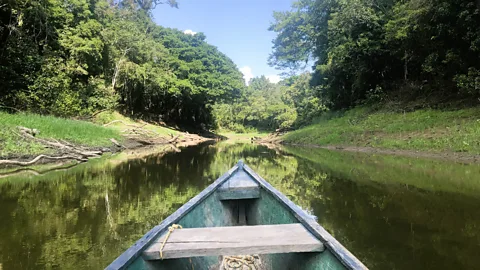
Known locally as "the natural cradle of Colombia", Puerto Nariño is an encouraging example of a community living in relative harmony with nature. In 2012, it was the first town in the country to be certified a "sustainable tourist destination" by the Ministry of Commerce, Industry and Tourism. It's surrounded by the kind of endangered rainforest that dominates discussions about climate change, and attracts a growing trickle of curious visitors keen to examine the health of the planet's "lungs" from the inside.
Recent news from the Colombian Amazon has been mixed. While deforestation rates reputedly fell 70 per cent in 2023, the region also suffered a record-breaking drought that endangered wildlife and led to unpredictable harvests.
Notwithstanding, my first impressions of Puerto Nariño were encouraging. Neat terracotta walkways lined with shapely trees and bushes fanned out in a well-ordered grid from the riverbank, and attractive wooden houses decorated with extravagant murals and eye-catching handicrafts reflected a strong Indigenous presence: around 80 per cent of the settlement's 6,000 inhabitants are from the Ticuna, Cocama and Yagua ethnic groups.
In contrast to other congested Colombian cities, cars and motorbikes are banned. In fact, the town has no roads and only two registered vehicles: a tractor for collecting rubbish and an ambulance in case of emergencies. Shiny silver litter bins stood at almost every street corner and, serenaded by birdsong, the place exuded an air of peace, tidiness and order.
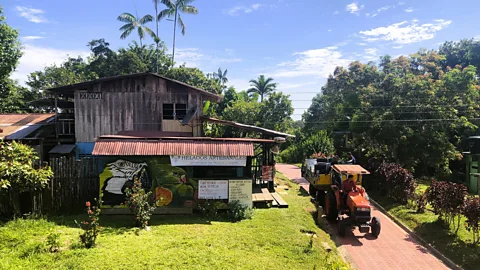
After paying a COP$15,000 (three pounds) entry tax that goes towards town maintenance, I got acquainted with the community on an exploratory walkabout. It wasn't a typical Amazonian village of muddy paths and unkempt foliage. Manicured grass-fronted stores selling colourful crafts, and a striking selection of surrealistic statues depicted the local wildlife (turtles, pink dolphins and parrots all featured). A boisterous game of five-a-side football was taking place under a large metal canopy by the river and community members with wheelbarrows and brooms were busily sweeping the pathways.
Founded in 1961, Puerto Nariño drew most of its population from Indigenous people who had been living in the region for centuries in separate family malocas (longhouses). It didn't take long to lure adventurous travellers.
"Starting in the 1980s and '90s, the town began to attract small groups of tourists, who stayed in wooden hotels with basic services," said Luz Jenny Torres, leader of sustainable tourism in the municipality. "Then at the beginning of the 2000s we started to see a more regular flow of tourists – family groups and university students. In 2004, the then-mayor Edilberto Suárez Pinto began to implement a vision for sustainability working hard to beautify the urban area, strengthen tourism in Indigenous communities and manage the tourist infrastructure."
In 2007, Torres proposed to the mayor that the municipality act as a pilot model for sustainable tourism countrywide. A plan was hatched, and Puerto Nariño became a poster child for green, grassroots tourism in a country still rejuvenating after years of conflict.
"There are five environmental programmes that are constantly monitored," explained Torres of the current setup. "Management of water, energy, solid waste and pollution; along with the protection and conservation of flora and fauna." For residents and travellers, this means showering with recycled rainwater, strolling streets unsullied by litter and enjoying close-up encounters with wildlife, from monkeys to eagles.
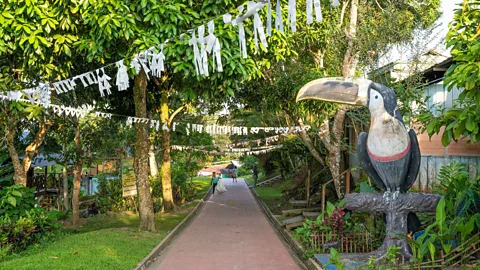
This environmental stewardship is nothing new. Nurturing a deep understanding of their natural surroundings, the area's Indigenous people have practiced sustainable agriculture since pre-Columbian times. Farming is still mainly organised through a network of chagras, small plots of land cleared of foliage and planted with crops during the dry season before being rotated to enable the soil to regain its fertility.
Local families grow enough food on their chagras for their own needs and then sell the surplus at a daily market that convenes down by the waterfront. Browsing the stalls, I admired brimming mounds of cassava, chillies, onions, squash and chicory, along with fruits such as bananas, papayas and mangos.
Dine in town and this is the food you'll be eating. Everyone, including Puerto Nariño's "poshest" hotel, Waira Selva, buys the bulk of their ingredients at the market.
Amazon fish were also on show, the basic protein in most dishes. There are 68 species in the surrounding rivers, including catfish, piranhas and pirarucu, one of the world's largest freshwater fish.
The local fishers double as environmental custodians monitoring wildlife in tandem with a foundation called Natütama, founded in 2005, that maintains an interpretation centre of river life in town staffed by Indigenous guides. Through Natütama, fishers recorded 1,044 pink dolphin and 134 highly endangered manatee sightings in 2023, with more detailed surveys planned for 2024. The numbers are not just important for conservation. Dolphin watching is a big lure for tourism, a mainstay of the regional economy. Wildlife trips can be organised with Indigenous guides who head off in small wooden motorboats called peque-peques in search of pink dolphins, sloths and turtles in nearby Lake Tarapoto, nominated a Ramsar wetlands site in 2018.
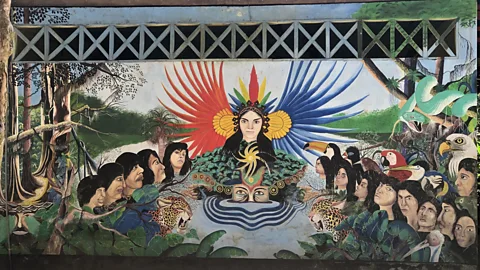
As well as monitoring endangered species, Natütama staff tutor children about Amazonian ecology and organise environmental workshops in local colleges and Indigenous communities. "Over the years, we have strengthened environmental and cultural education in schools, focusing particularly on the importance of grandparents," said Marelvi Laureano, an education coordinator for the foundation, of their work sowing intergenerational understanding. "They are the people that provide the cultural knowledge that helps generate respect and care towards the community."
The interpretation centre acts as an environmental and educational hub. "It recreates the year's two different seasons," explained Laureano, referring to exhibits that teach visitors about the wet and dry times of year. "Inside, you'll learn about the local lakes and jungle, how to identify the plants, fish and aquatic animals, and how they are divided on a natural scale."
Elsewhere in the municipality, travellers can get an insight into Indigenous life. "Visitors can learn dances, taste typical Indigenous food, hear myths and legends about different animals, and see the work we do caring for the environment," said Laureano.
One of the refreshing aspects of Puerto Nariño's conservation is that it's locally led. "Indigenous people represented by the organisation ATICOYA, have always participated in everything related to the process," Torres explained.
Enlightened after a visit to Natütama, I took a guided boat trip to Lake Tarapoto where I was allowed to swim (despite the piranhas!) and rounded off the day by climbing Puerto Nariño's emblematic wooden tower for a panoramic view of the river and surrounding jungle.
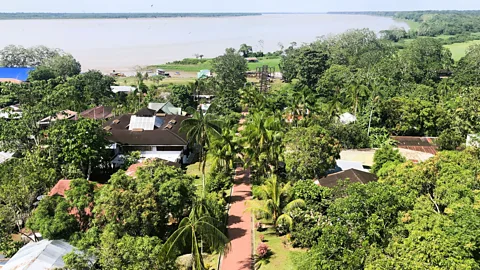
At the foot of the tower is one of several outlets that sell homemade ice cream in an array of tropical flavours. I chose camu camu, made with a purplish cherry-like fruit high in vitamin C, and strolled around town soaking up more of its creative eco-initiatives: plant pots fashioned out of recycled plastic bottles; fastidiously kept gardens; and a water filtration plant where most of the town comes to refill their drinking containers.
My favourite spot was a small restaurant with a terrace opposite the five-a-side football court where I enjoyed grilled fish to the soundtrack of cheers from the players before retiring to my modest cabin accommodation.
Nighttime in the traffic-free tranquillity of Puerto Nariño's was cathartic. Fed by the grassroots power of the community, the town has created an unlikely blend of jungle mellowness and Scandinavian-style order in the middle of the world's largest rainforest. It might not be the ultimate cure for the tricky environmental issues facing the Amazon, but it's an encouraging start.








